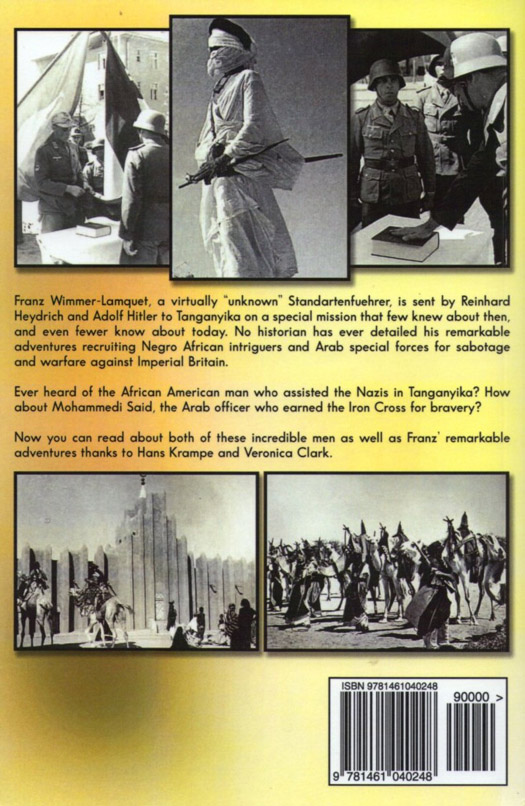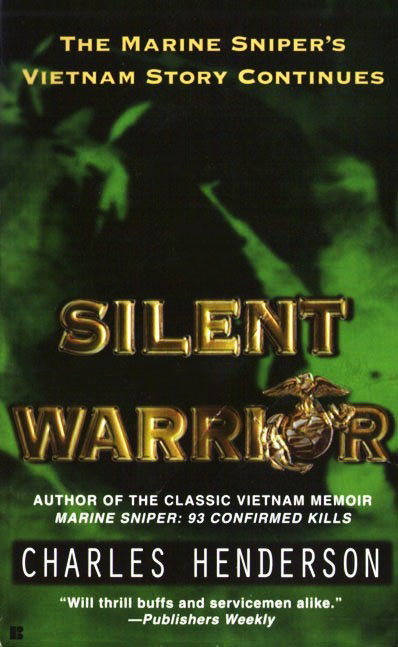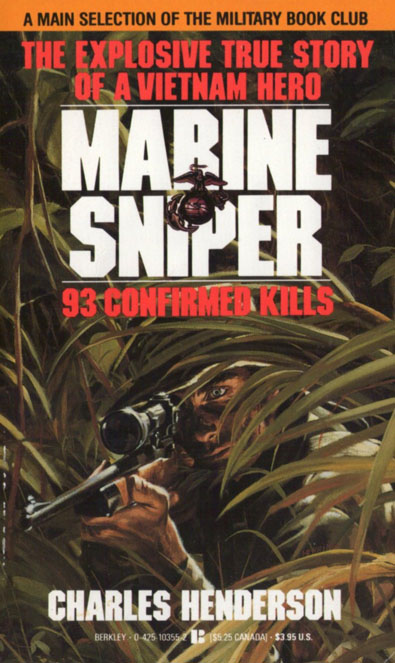

This 2010 book is full of information that the system has gone to great lengths to hide from the public. The title is taken from a WW2 era newspaper article about African and German collaboration. The pictures say a thousand words. Open the books pages and prepare to be blown away.
How can anyone who's eyes have been opened ever believe the system, the controlled-media and their puppets ever again?
I purchased my copy from Amazon.com and it was very affordable. More and more truth is coming to the light everyday thanks to the internet.
To read more about this topic, go to our own article and database: Adolf Hitler and the the Army of Mankind
[Below: Back]
There is so much information here, so much to say, that it is difficult to begin! Well, first off, this book begins with a very interesting and informative forword by Veronica Clark. Here she lays down information regarding the many Arab and black African Axis volunteers in WW2. One Axis unit was so incredibly diverse it boasted 2,200 men who spoke 20 different languages! Incredible. All of them had at least one belief in common: If Germany won the war their countries would finally be free from the burtality of Western Imperialism. Adolf Hitler promised it. It was one of the reasons why the Arabs had the slogan: 'Allah Above Us, and Hitler Beside Us'
Continuing Veronica's introduction, she quotes a very interesting conversation between Adolf Hitler and Otto Wagener. Speaking of the Semites (Arabs), he said: 'The Semites seem to recognize their racial compatriots. Furthermore, it seems to me that they understand and know more about race than Europe does...
It's fascinating that so many non-German and non-white races fought until the bitter end, and many died, for the Axis cause. Thousands of Arabs fought the Allies wearing the eagle and swastika on their uniforms. Many of them even fought at the doorstep of the German capital, Berlin, and furthermore, fought to the death in the ruins within. German Major Schacht confirmed that there were at least 100 Arabs in the final battle of Berlin.
Major Schacht wrote, 'In at least two instances I owed my life to the Arabs. Their losses were in proportion to their courage.'
The rest of the book reveals the fascinating life story of Hans Wimmer-Lamquet, a German who began his service to his country as a teenager, working for none other than Reinhard Heydrich. His story starts in Tanganyika, East Africa, where he runs a plantation, secretly making contacts in the former German colony. Most interestingly, on at least one occasion he works with an African American man. Unfortunately he doesn't reveal too much information about who this man is or his ties.
Eventually, Hans would return to Germany only to be ordered back to Africa, where he would assist in a revolt against the British in Iraq. Unfortunately, due to various circumstances the revolt failed, and Iraq's leader Rashid Ali al-Gaylani and The Grand Mufti sought asylum in Germany.
Hans Wimmer-Lamquet took a number of seasoned Arab officers and soldiers back with him to Germany however. These men would be the basis of the Arabic armed forces he would later control back in Africa. As time went on Hans would tactically marry an Arabic princess, the daughter of a powerful Sultan who had allied himself with the Axis. He even operated brothels in Africa, in order to gain information from his enemies' through 'pillow talk'.
Toward the last part of WW2, with personal powers given to him by Adolf Hitler himself, he built a special forces/spy training ground for African volunteers.
This book is an interesting read and tells a unique story of WW2. The level of trust and cooperation between the Germans and the African/Arab world is something mainstream history would never reveal.
[Above: Back]
This is sort of a companion book to Henderson's first book 'Marine Sniper'. In addition to information derived from various sources, Silent Warrior contains material that was cut by the publisher of the aforementioned book (over 300 pages!). Marine Sniper told the story of the extraordinary sniper Carlos Hathcock, who served two tours in the Vietnam war and racked up 93 confirmed kills, with many more probable ones.
Hathcock was without peer when it came to his shooting skills, which were only matched by his bravery and courage. His second tour of 'Nam was ended when the vehicle he was riding on with other Marines was exploded by an I.E.D.. All inside the armored transport were instantly killed while those riding atop it were knocked unconscious. All except Carlos Hathcock. Through the inferno he pulled each of his unconscious comrades off the burning vehicle, thus saving all of their lives. For this act of heroism he suffered burns over his entire body. The burns would end his career as a shooter.
This book has a lot of interesting aspects, but is far inferior to Marine Sniper, action-wise. There are a lot of boring parts involving Hathcock's civilian life. But anyone who enjoyed Marine Sniper naturally should read 'Silent Warrior'. It's an easy read, written by the only man, also a marine, who Hathcock would tell his tale.
Hathock was so successful killing his enemies that the communist NVA forces in Vietnam put a bounty on his head. Three months of officer pay to anyone who killed him. A fortune to the average Vietcong or NVA guerilla. They also put together a special team of expert snipers to hunt Hathcock. As Silent Warrior details, Hathcock actually kills the team's leader by shooting him in the eye through his scope! That's right, the sniper was just about to shoot him, but Hathcock shot first. Carlos Hathcock was already famous, but this shot made him a legend.
Silent Warrior also talks about a communist guerilla they called 'The Apache'. This female sniper was infamous because of what she did to her victims after they surrendered to her. She gruesomely tortured them and sometimes skinned them alive, their screams echoing for miles through the hot jungle. But the Silent Warrior Carlos Hathcock put an end to her too. The marines and their Vietnamese allies celebrated. The deed spread like wildfire.
Carlos also put an end to another communist monster, a Frenchman working for the NVA named Philip Metz. He was an interrogator who sadistically tortured his victims, be they French, Vietnamese or American. All died after his monstrous hands were done with them. He would strip his victims and then admire their private parts. Then he would tell them that he preferred young Oriental boys and their 'hairless genitals', 'smooth skin' and 'willingness to please'. But a 'well-endowed Frenchman, covered with black, coarse hair, could be exciting, too'.
The monster Metz would then erotically caress his victims with a straight razor. The next step would be to have his NVA guards tie the victim to a chair 'leaving his penis and testicles fully accessible and vulnerable'. The guards would then urinate on the man and Metz would then talk of how sexually stimulating being urinated on was but also urine's ability to conduct electricity...
Hathcock put a bullet through this monster's chest, ending his sickness, and further enraging the NVA leaders.
The book mentions an aircraft multiple veterans have mentioned in other books about the Vietnam war I've read. It's an aircraft referred to here as 'Spooky'. It's a twin engine fixed wing plane normally used for cargo or troop transport. But Spooky is armed to the teeth with 20mm chain guns, rockets and all manner of armaments. It literally cuts down the jungle with its firepower. It's like a magical beast to the Americans, and probably a devil incarnate to the enemy.
There is a very funny story I have to mention also. It is about a fuel barrel that accidentally rolled down a hill in an American base camp. This errant barrel rolls into the masses of mines and barbed wire which surround the camp. It creates the problem of 'how do we get it out?' They decide to blow it up. Hathcock volunteers his services. He says he could shoot it with an incendiary bullet, but the pompous commander doesn't want his help. He actually has his men launch mortars and other artillery at the barrel, and they all miss! Not deterred, he then calls in an air strike!!! And it misses too!!! Eventually one of Hathcock's men shoots it secretly during the chaos...
All in all, this was a good book, and I'll end it with the words from a brass plaque from a rifle that was awarded to Hathcock:
"There have been many Marines, and there have been many marksmen, but there has been only one sniper--Gunnery Sergeant Carlos N. Hathcock. One Shot--One Kill."
[Above: Back]
____________________________________________________
[Above: Marine Sniper was first published in 1986]
-|-Page Three -|-

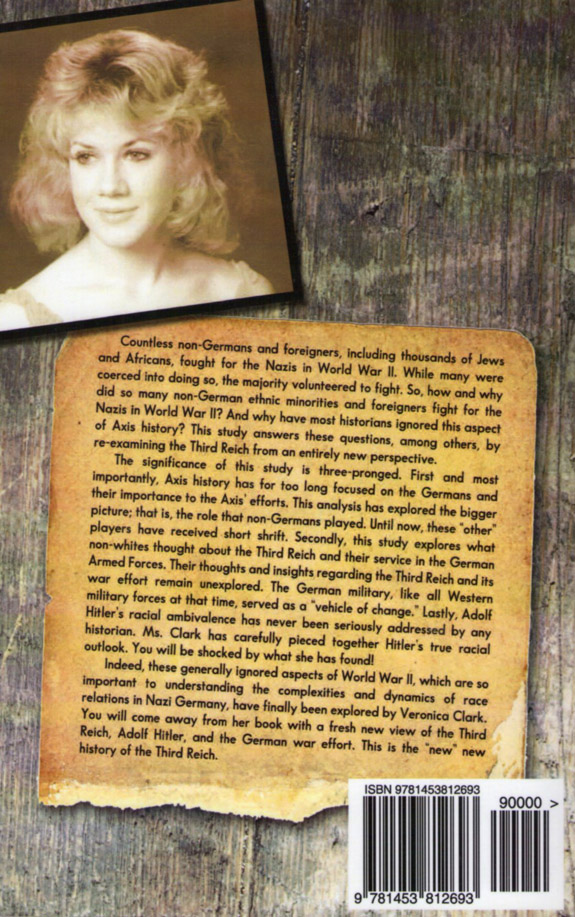
Swastika & Scimitar
"Brothers in Arms"
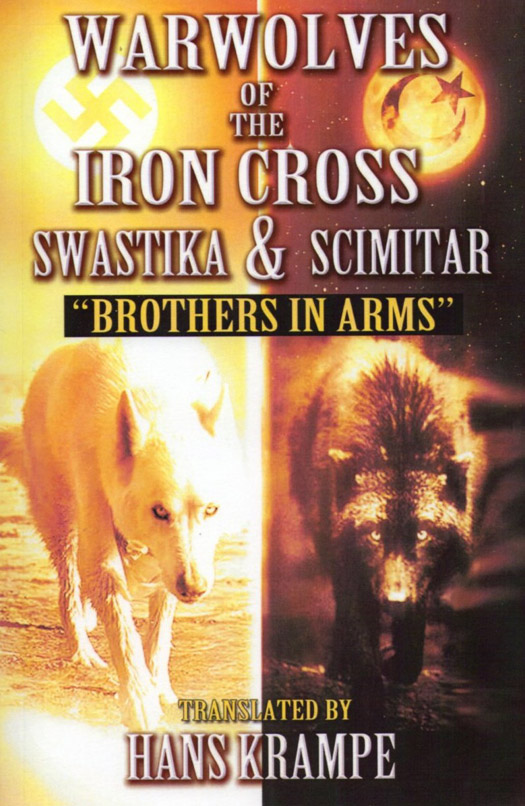
We Germans have gotten into the habit of looking for friends only in Europe-if possible, among people of the same race. Perhaps that's a mistake. Perhaps it's much easier to find friends among other races.'
